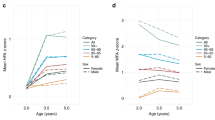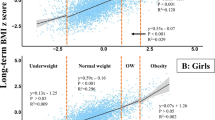Abstract
Objectives:
Longitudinal growth data of children were analyzed to clarify the relationship between the timing of body mass index (BMI) rebound and obesity risk in later ages.
Subjects/Methods:
Of 54 558 children born between April 2004 and March 2005 and longitudinally measured in April and October every year in the preschool period, 15 255 children were analyzed wherein no longitudinal measurement is missing after 1 year of age. BMI rebound age was determined as the age with smallest BMI value across longitudinal individual data after 1 year of age. Rebound age was compared between overweight and non-overweight groups. The subjects were divided into groups based on the timing of rebound. The sex- and age-adjusted mean of the BMI, height and weight s.d. scores for age group, along with 6 months weight and height gain, were compared among groups using analysis of covariance.
Results:
Among those who were overweight at 66–71 months of age, BMI rebound age obtained at approximately 3 years of age was compared with the non-overweight group, whose BMI rebound age was utmost 66 months or later (P<0.001). The comparison among BMI age group showed that earlier BMI rebound results in larger BMI (P<0.001) and larger weight and height gain after the rebound (P<0.001). Among the group with BMI rebound earlier than 30 months of age, low BMI was observed (P<0.001). Slight elevation of height and weight gain was observed before the BMI rebound among groups with rebound age earlier than 60 months of age (P<0.001).
Conclusion:
Earlier BMI rebound timing with pre-rebound low BMI leads to greater childhood obesity risk; hence, early detection and prevention is necessary for such cases.
This is a preview of subscription content, access via your institution
Access options
Subscribe to this journal
Receive 12 print issues and online access
$259.00 per year
only $21.58 per issue
Buy this article
- Purchase on Springer Link
- Instant access to full article PDF
Prices may be subject to local taxes which are calculated during checkout


Similar content being viewed by others
References
Plachta-Danielzik S, Bosy-Westphal A, Kehden B, Gehrke MI, Kromeyer-Hauschild K, Grillenberger M et al. Adiposity rebound is misclassified by BMI rebound. Eur J Clin Nutr 2013; 67: 984–989.
Rolland-Cachera MF, Deheeger M, Bellisle F, Sempe M, Guilloud-Bataille M, Patois E . Adiposity rebound in children: a simple indicator for predicting obesity. Am J Clin Nutr 1984; 39: 129–135.
Freedman DS, Kettel Khan L, Serdula MK, Srinivasan SR, Berenson GS . BMI rebound, childhood height and obesity among adults: the Bogalusa Heart Study. Int J Obes Relat Metab Disord 2001; 25: 543–549.
Eriksson JG, Forsen T, Tuomilehto J, Osmond C, Barker DJ . Early adiposity rebound in childhood and risk of type 2 diabetes in adult life. Diabetologia 2003; 46: 190–194.
Taylor RW, Grant AM, Goulding A, Williams SM . Early adiposity rebound: review of papers linking this to subsequent obesity in children and adults. Curr Opin Clin Nutr Metab Care 2005; 8: 607–612.
Williams SM . Weight and height growth rate and the timing of adiposity rebound. Obes Res 2005; 13: 1123–1130.
Rolland-Cachera MF, Deheeger M, Maillot M, Bellisle F . Early adiposity rebound: causes and consequences for obesity in children and adults. Int J Obes 2006; 30 (Suppl 4): S11–S17.
Eriksson JG . Early growth and coronary heart disease and type 2 diabetes: findings from the Helsinki Birth Cohort Study (HBCS). Am J Clin Nutri 2011; 94 (6 Suppl): 1799S–1802S.
Sovio U, Mook-Kanamori DO, Warrington NM, Lawrence R, Briollais L, Palmer CN et al. Association between common variation at the FTO locus and changes in body mass index from infancy to late childhood: the complex nature of genetic association through growth and development. PLoS Genet 2011; 7: e1001307.
Matsubara H, Ishikuro M, Kikuya M, Chida S, Hosoya M, Ono A et al. Design of the Nationwide Nursery School Survey on Child Health Throughout the Great East Japan Earthquake. J Epidemiol 2016; 26: 98–104.
Kato N, Takimoto H, Sudo N . The cubic functions for spline smoothed L, S and M values for BMI reference data of Japanese children. Clin Pediatr Endocrinol 2011; 20: 47–49.
Statistics and Information Department. MoH, Labour and Welfare. Annual report on vital statistics of Japan 2006.
Kato N, Sauvaget C, Kato T . Large summer weight gain in relatively overweight preschool Japanese children. Pediatr Int 2012; 54: 510–515.
Cole TJ, Bellizzi MC, Flegal KM, Dietz WH . Establishing a standard definition for child overweight and obesity worldwide: international survey. BMJ 2000; 320: 1240–1243.
Kuczmarski RJ, Ogden CL, Guo SS . 2000 CDC Growth Charts for the United States: Methods and Development. National Center for Health Statistics: Atlanta, GA, USA, 2002; vol. 11.
Kato N, Sato K, Takimoto H, Sudo N . BMI for age references for Japanese children—based on the 2000 growth survey. Asia Pac J Public Health 2008; 20 (Suppl): 118–127.
Sovio U, Kaakinen M, Tzoulaki I, Das S, Ruokonen A, Pouta A et al. How do changes in body mass index in infancy and childhood associate with cardiometabolic profile in adulthood? Findings from the Northern Finland Birth Cohort 1966 Study. Int J Obes 2014; 38: 53–59.
Flexeder C, Thiering E, Kratzsch J, Klumper C, Koletzko B, Muller MJ et al. Is a child's growth pattern early in life related to serum adipokines at the age of 10 years? Eur J Clin Nutr 2014; 68: 25–31.
Taylor RW, Williams SM, Carter PJ, Goulding A, Gerrard DF, Taylor BJ . Changes in fat mass and fat-free mass during the adiposity rebound: FLAME study. Int J Pediatr Obes 2011; 6: e243–e251.
Kain J, Corvalan C, Lera L, Galvan M, Uauy R . Accelerated growth in early life and obesity in preschool Chilean children. Obesity 2009; 17: 1603–1608.
Williams S, Davie G, Lam F . Predicting BMI in young adults from childhood data using two approaches to modelling adiposity rebound. Int J Obes Relat Metab Disord 1999; 23: 348–354.
Williams SM, Goulding A . Patterns of growth associated with the timing of adiposity rebound. Obesity 2009; 17: 335–341.
Koyama S, Ichikawa G, Kojima M, Shimura N, Sairenchi T, Arisaka O . Adiposity rebound and the development of metabolic syndrome. Pediatrics 2014; 133: e114–e119.
Ohlsson C, Lorentzon M, Norjavaara E, Kindblom JM . Age at adiposity rebound is associated with fat mass in young adult males-the GOOD study. PLoS One 2012; 7: e49404.
Campbell MW, Williams J, Carlin JB, Wake M . Is the adiposity rebound a rebound in adiposity? Int J Pediatr Obes 2011; 6: e207–e215.
Boonpleng W, Park CG, Gallo AM . Timing of adiposity rebound: a step toward preventing obesity. Pediatr Nursing 2012; 38: 37–42.
Kroke A, Hahn S, Buyken AE, Liese AD . A comparative evaluation of two different approaches to estimating age at adiposity rebound. Int J Obes 2006; 30: 261–266.
Chivers P, Hands B, Parker H, Bulsara M, Beilin LJ, Kendall GE et al. Body mass index, adiposity rebound and early feeding in a longitudinal cohort (Raine Study). Int J Obes 2010; 34: 1169–1176.
Wen X, Kleinman K, Gillman MW, Rifas-Shiman SL, Taveras EM . Childhood body mass index trajectories: modeling, characterizing, pairwise correlations and socio-demographic predictors of trajectory characteristics. BMC Med Res Methodol 2012; 12: 38.
Hof MH, Vrijkotte TG, de Hoog ML, van Eijsden M, Zwinderman AH . Association between infancy BMI peak and body composition and blood pressure at age 5–6 years. PLoS One 2013; 8: e80517.
Acknowledgements
This study was conducted as a part of the 'Surveillance study on child health in the Great East Japan Earthquake disaster area' and supported in full by funding from the Health and Labour Sciences Research Grant (H24-jisedai-shitei-007, fukkou). The following are the members of the working group for childhood physical development evaluation based on the grant above: Shigeo Kure (PI), Professor and Chairman, Department of Pediatrics, Tohoku University; Susumu Yokoya, Department of Medical Subspecialties, National Center for Child Health and Development; Toshiaki Tanaka, President, Japanese Society of Auxology; Noriko Kato, Research Managing Director, National Institute of Public Health; Tsuyoshi Isojima, Assistant Professor, Department of Pediatrics, Graduate School of Medicine, The University of Tokyo; Shoichi Chida, Professor and Chairman, Department of Pediatrics, Iwate Medical University; Mitsuaki Hosoya, Professor and Chairman, Department of Pediatrics, Fukushima Medical University; Atsushi Ono, Research associate, Department of Pediatrics, Fukushima Medical University; Zentaro Yamagata, Professor, Department of Health Sciences, Yamanashi University; Hiroshi Yokomichi, Assistant Professor, Department of Health Sciences, Yamanashi University; Soichiro Tanaka, Associate Professor, Department of Pediatrics, Tohoku University; Shinichi Kuriyama, Professor, International Research Institute of Disaster Science (IRIDeS), Tohoku University; Masahiro Kikuya, Associate Professor, Tohoku Medical Megabank Organization (ToMMo), Tohoku University; Mami Ishikuro, Assistant Professor, ToMMo, Tohoku University; Hiroko Matsubara, Postdoctoral research associate, IRIDeS, Tohoku University. We wish to express their appreciation to the nursery teachers who completed questionnaires, as well as to Dr Ikuo Endo, President of the Japan Society for Well-Being of Nursery-Schoolers for their support and cooperation.
Author information
Authors and Affiliations
Corresponding author
Ethics declarations
Competing interests
The authors declare no conflict of interest.
Rights and permissions
About this article
Cite this article
Kato, N., Isojima, T., Yokoya, S. et al. Earlier BMI rebound and lower pre-rebound BMI as risk of obesity among Japanese preschool children. Int J Obes 42, 52–58 (2018). https://doi.org/10.1038/ijo.2017.242
Received:
Revised:
Accepted:
Published:
Issue Date:
DOI: https://doi.org/10.1038/ijo.2017.242



